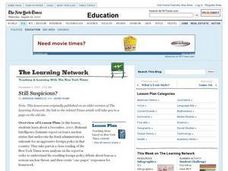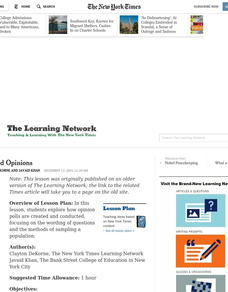Curated OER
The Reader's Recourse
Young scholars discover the recourse newspapers face for reporting wrong information. After reading an article, they examine the dispute between a pharmaceutical company and the New York Times. They evaluate the roles of the editor and...
Curated OER
Graphic Accounts
Students identify the use of different types of bar graphs. They analyze graphs used in the New York Times to compare the estimated cost of the war in Iraq to other hypothetical expenditures and reflect on how graphs can help illustrate...
Curated OER
Ho Ho Poetry
Students read about the sights and sounds of a Las Vegas Christmas. They use words and phrases taken from articles in a recent issue of the New York Times to create a holiday-themed "found Poem."
Curated OER
Stranger Than Fiction
Students reflect on the importance of science literacy. They review the year's science curriculum by reading, discussing and writing questions on teacher-selected New York Times articles and the related science content.
Curated OER
High Profiles
Students research and write newspaper articles about current world leaders, using a New York Times International article as a model. They research a current world leader's personal background and political history.
Curated OER
Much Ado About Nothing?
Students explore their feelings regarding the celebration of various holidays. Using the New York Times article as a model, students write articles critiquing what they consider to be inappropriate expressions of holiday spirit.
Curated OER
Walking in Other People's Shoes
Students study the story of student journalist Casey Parks' September, 2006, journey to Central Africa with New York Times columnist, Nicholas Kristof. They then act as representatives to the tourism boards of developing countries and...
Curated OER
Scooting Away from Justice?
Students examine President Bush's July 2007, decision to commute the 30-month sentence of former White House official, I. Lewis 'Scooter' Libby by reading a New York Times article. They scan editorial sources on various sides of the...
Curated OER
Current Contexts
Young scholars examine how they are affected by world affairs. After reading an article, they examine Otto Frank's attempts to immigrate to America. Using the New York Times, they identify examples of news, advertisements and...
Curated OER
All Aboard the Innovation Train
Students read "Next Stop for the Subway, a Fully Automated Future" from The New York Times and consider the effect of technology on their town or city. After discussing arguments for and against the new computer-based subway system in...
Curated OER
Still Suspicious?
Students read and analyze The New York Times news article "An Assessment Jars a Foreign Policy Debate About Iran." They answer comprehension questions, evaluate both sides of the debate, and write a one page report on the article.
Curated OER
The Long and Short of It
Learners take a look back at the week's news by exploring the news summaries article offered in The New York Times' Week in Review section each week. They look further into ongoing news stories of interest to them in order to create...
Curated OER
Measured Opinions
Young scholars read "Public Is Wary but Supportive on Rights Curbs," at the New York Times online. They explore how opinion polls are created and conducted, focusing on the wording of questions and the methods of sampling a population.
Curated OER
A Critical Role
Students read a New York Times review of the Museum of the African Diaspora in San Francisco. They discuss the roles and responsibilities of a cultural critic, and prepare for a visit to a local museum in order to write their own reviews.
Curated OER
Make It or Break It
Young scholars study about "breaking news" by analyzing the New York Times' coverage of the July 2006 bombing of seven commuter trains in Mumbai, India. They write their own breaking news stories for homework.
Curated OER
What's Your Angle?
Students examine The New York Times' coverage of immigrants' rights in order to gain an understanding of how different news angles function. They assess the angles of different news media outlets, such as television, radio, and Internet...
Curated OER
Where Were You?
Students examine various New York Times readers' reflections on the life and death of President John F. Kennedy, by reading and discussing "Readers Reflect on President John F. Kennedy." Students then write their own personal...
Curated OER
Public Land
Students examine the needs of their community for public space and determine the solutions to math problems related to planning landscape designs. They read and discuss an article from the New York Times, create their own designs for a...
Curated OER
Showing Good Taste
Learners distinguish the important elements of well-written restaurant reviews by analyzing and evaluating reviews from The New York Times and by writing their own reviews of favorite dining locations.
Curated OER
Making 'Friends'
Young scholars read "Fans Gear Up to Say Goodbye to 'Friends'" from The New York Times and discuss the elements of the sitcom 'Friends' that made it such a success. After brainstorming reasons for 'Friends' popularity, students work in...
Curated OER
All the President's Men and Women
Students research responsibilities, programs and government departments of leaders that make up the presidential cabinet, in the form of a Web Exploration, after reading "Dueling Power Centers" from The New York Times.
Curated OER
The Reel World
Students explore the ways in which the New York Times column 'Taking the Kids' analyzes whether or not current movies are appropriate for different ages of Students. They explore past articles from the column and create movie posters.
Curated OER
Working It Out
Students participate in a simulation in which they are arbitrarily assigned different work roles and compare their experiences to those discussed in a New York Times article about the racial divisions in a pork production plant.
Curated OER
High Anxiety
The Learning Network section of the New York Times produces high-quality teaching materials. This issue gets middle or high schoolers reading an article about how people use art to express their response to high-stress events. They work...























